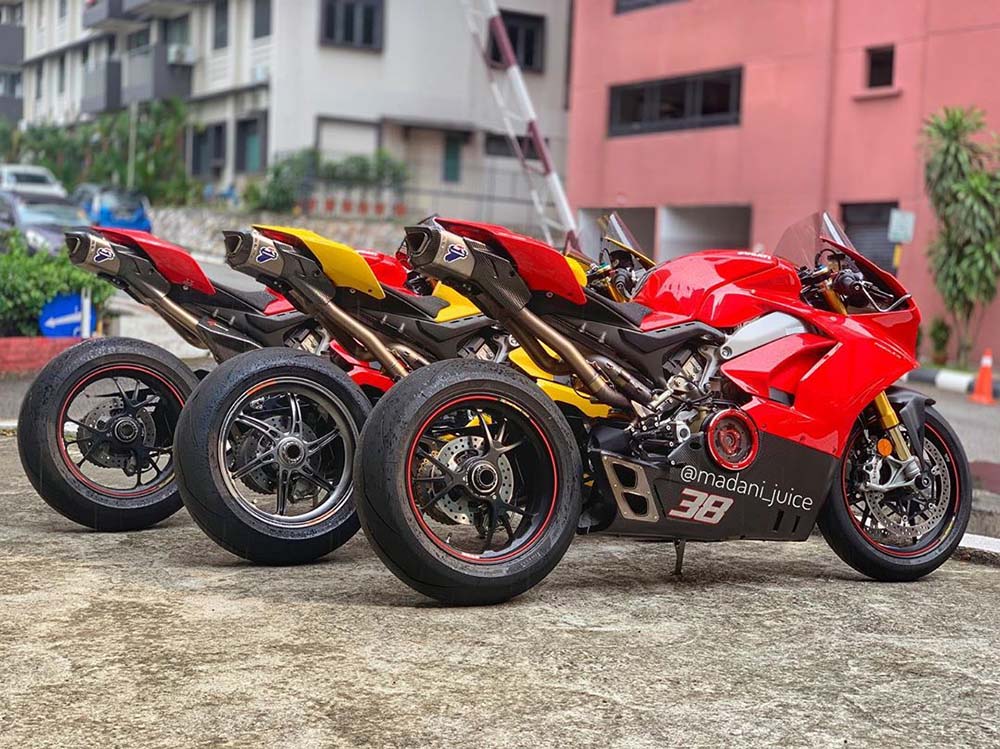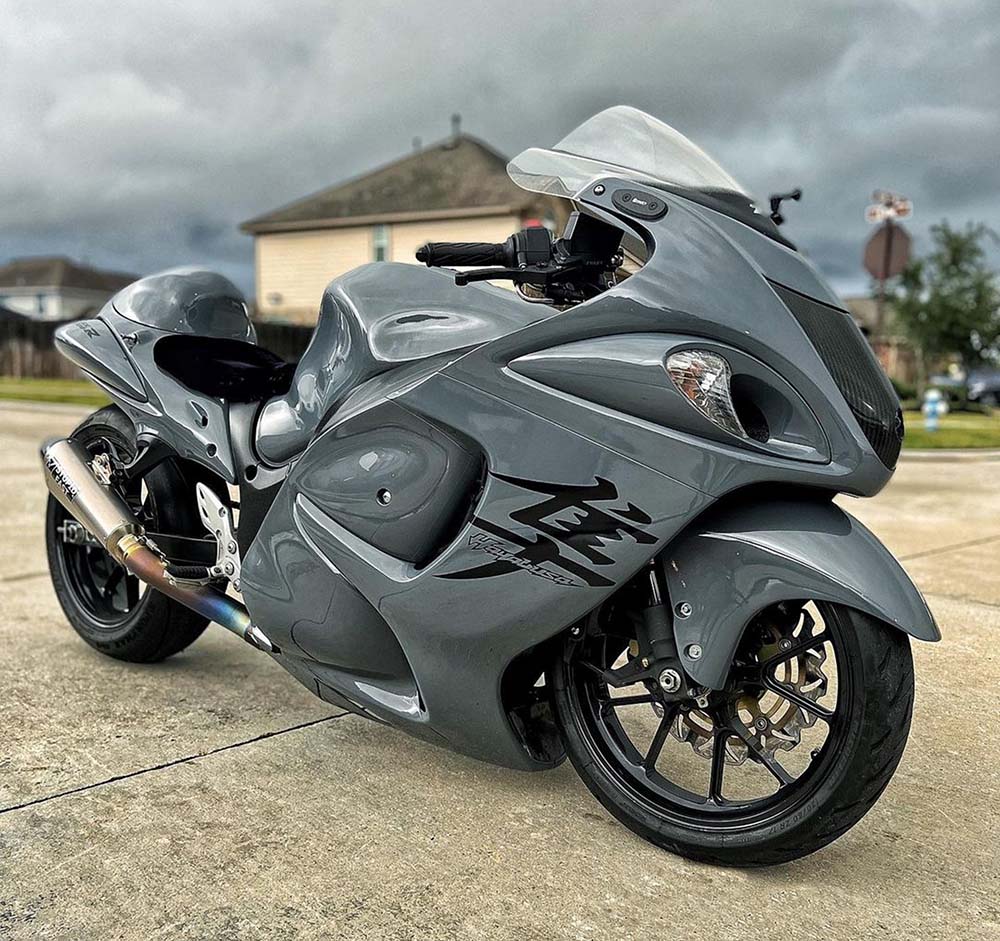For those who are not familiar with the workings of a motorcycle exhaust system, understanding the difference between aftermarket slip-on exhausts and full exhaust systems may seem confusing at first. However, this simple modification isn't complicated. By replacing your OEM parts with a slip-on exhaust, you can improve the look and sound of your motorcycle with minimal hassle. In this article, we'll cover the basics of slip-on exhausts, their benefits, and how they differ from full-exhaust systems.
The Basics of a Motorcycle Exhaust System
What is a motorcycle exhaust? A motorcycle exhaust system plays a critical role in optimizing the performance of the engine while ensuring the safety and comfort of the rider. At their core, these systems are designed to efficiently manage the byproducts of the combustion process, namely noxious gases, and redirect them away from the rider, muffle the sound of the engine, and help the engine perform better.
How Exhaust Systems Work
Before diving into the specifics of slip-on exhausts, it's important to establish a foundational understanding of motorcycle exhaust systems. The fundamental role of an exhaust system is the expulsion of gases generated during the combustion of an air/fuel mixture in the engine's combustion chamber. The basic components of a motorcycle exhaust system include the exhaust manifold, also known as the header pipe, which collects the exhaust gases from each cylinder. From the manifold, the gases flow into the exhaust pipes, which are often designed to balance the pressure and optimize the exhaust flow.
As the gases move through the system, they pass through the catalytic converter, a component that helps reduce harmful emissions by converting pollutants into less harmful substances. Finally, the gases exit through the muffler, which not only reduces noise but also contributes to the back pressure required for optimal engine performance. Typically, OEM exhaust mufflers help to reduce noise from the engine to adhere to local noise regulations.
Additionally, motorcycle exhaust systems can be customized to enhance performance or achieve a specific aesthetic. Aftermarket exhaust systems often feature high-flow designs, lighter materials, and improved tuning to increase horsepower and torque. Some riders may opt for a louder exhaust note for aesthetic or safety reasons, as a louder exhaust can make the motorcycle more audible to other road users. However, it's essential to strike a balance between performance, sound, and compliance with local noise regulations.
Overall, motorcycle exhaust systems are made up of different components that not only manage exhaust gases but also play a significant role in defining the appearance, sound, and performance of the motorcycle.

Understanding Aftermarket Slip-On Exhausts
Slip-on exhausts focus primarily on the muffler section of the exhaust system. These modifications are designed to be user-friendly, allowing riders to upgrade their exhaust system without the need for extensive technical expertise. The name "slip-on" comes from how easy the installation of this modification is for motorcycle owners, as they can be slipped onto the existing header pipes, making them a cost-effective and accessible choice for many.
Since OEM parts typically use cost-effective materials, aftermarket parts offer motorcycle owners the chance to upgrade to a more expensive and higher-quality material. Aftermarket exhaust materials are often a much lighter construction than stock mufflers, contributing to an overall reduction in the motorcycle's weight. For example, our lightweight, aerospace-quality stainless Single Alien Head Slip-On (3/4 System) ZX-10R (16-20) has a weight savings of 74% compared to the OEM muffler/catalytic converter. With a significant weight reduction, riders can expect better handling and an overall better performance experience.
Beyond the weight factor, slip-ons can optimize exhaust flow, allowing the engine to expel gases more efficiently. This improved flow can lead to a modest increase in horsepower and torque, providing riders with a more responsive and powerful riding experience. Additionally, slip-on exhausts are renowned for their ability to transform the sound profile of a motorcycle. While stock exhaust systems are designed to comply with noise regulations and emission standards, slip-ons unleash a more aggressive and distinctive exhaust note. Our Single Penta-Carbon Slip-On System (Black) H2 SX / SE / SE+ (18-21) offers a unique, aggressive sound that many motorcycle owners find appealing over the stock sound.
How It Works
Slip-on motorcycle exhausts operate by replacing the stock muffler of a motorcycle while leaving the rest of the exhaust system intact. Unlike full exhaust systems that involve a comprehensive overhaul of the entire assembly, slip-ons are designed to be easily installed by slipping onto the existing header pipes.
The muffler's shape, size, and internal components, such as baffles and butterfly valves, collectively influence the exhaust sound. So, essentially, the modified internal structure of the muffler is able to transform the exhaust sound, giving it a deeper, more resonant quality that is more aggressive-sounding than the stock option. This alteration in sound not only adds to the overall riding experience but also provides a distinctive noise, announcing the presence of the motorcycle on the road, which may aid in road safety.
Comparing Slip-Ons to Full Exhaust Systems
The distinction between slip-on exhausts and full-system exhausts lies in their scope and impact on a motorcycle's performance. Slip-on exhausts, being a more straightforward modification, are primarily chosen for aesthetic and sound enhancement rather than radical performance gains. While slip-ons do contribute to a modest increase in performance, they are not designed to revolutionize the entire exhaust system. Instead, they offer riders an accessible and cost-effective way to personalize their motorcycle's appearance and sound profile. The installation of slip-on exhausts is often hassle-free, involving the replacement of the stock muffler without significant alterations to the rest of the exhaust assembly.
On the other hand, full-system exhausts represent a comprehensive upgrade to the entire motorcycle exhaust system. The advantage of a full exhaust system lies in its ability to unlock more substantial performance gains. By optimizing the entire exhaust flow from the engine cylinders to the tailpipe, full-system exhausts contribute to a more efficient combustion process, resulting in increased horsepower, torque, and overall engine responsiveness. However, the installation of a full system is a more intricate process, often requiring professional expertise, and comes with a higher price tag compared to slip-on exhausts.
You'll also have to consider tuning your engine after this kind of upgrade. When opting for a full exhaust system, all motorcycle owners need to consider the importance of tuning to maximize the benefits. The modifications introduced by a full-system exhaust can alter the air-to-fuel ratio during the combustion process. To harness the full potential of the upgraded exhaust system, tuning is an essential next step. This involves adjusting the motorcycle's fuel injector settings to ensure an optimal balance between air and fuel.
Tuning helps prevent issues like running too lean or too rich, which can impact both performance and engine longevity. Some riders choose to seek professional tuning services to achieve the perfect balance between the upgraded exhaust and the engine's requirements. However, all of our exhaust systems come with preset maps either for racing or street use depending on your motorcycle's fuel. Check out our map support after purchasing an exhaust, and be sure to fill out an application to receive your customized map.

The Benefits
Why replace your OEM exhaust with an aftermarket option? Slip-on exhausts offer a range of benefits that make them particularly appealing for casual riders who predominantly ride in the streets. One of the most desirable advantages of upgrading to a slip-on exhaust lies in the distinct sound profile it provides. Unlike the more subdued and conforming tones of stock mufflers, slip-ons unleash a more aggressive exhaust sound. This characteristic not only enhances the overall riding experience but also adds a personalized touch to the motorcycle's presence on the road. For those who want to customize their bike's sound but aren't looking for a full exhaust system replacement, slip-ons offer an accessible means to inject a dose of individuality into their motorcycles.
Beyond the allure of improved sound, high-quality slip-on exhausts are also a significant style upgrade for motorcycle owners seeking to customize the aesthetics of their bikes. Available in various materials, finishes, and designs, slip-ons provide riders with the flexibility to choose an exhaust that complements their bike's overall look and aligns with their personal style. Whether it's the sleek elegance of stainless steel, the lightweight allure of titanium, or the high-tech appeal of carbon fiber, slip-ons enable riders to make a visual statement while enhancing your motorcycle's look.
Additionally, the ease of installation is another noteworthy benefit of slip-on exhausts, making them an ideal choice for riders who want to try a DIY approach. Unlike full exhaust systems that may require professional expertise and specialized tools, slip-ons are designed to be user-friendly. Motorcycle owners can often perform the installation themselves with basic hand tools, eliminating the need for costly professional assistance. This accessibility not only makes slip-on exhausts a budget-friendly modification but also empowers riders to take an active role in personalizing and maintaining their motorcycles. The straightforward installation process ensures that riders can swiftly and easily enjoy the benefits of their chosen slip-on exhaust, whether it's for the enhanced sound, style, or both.
How To Choose A Slip-On Exhaust
Choosing the right slip-on exhaust for your motorcycle involves thoughtful consideration of various factors to ensure it aligns with your preferences and performance goals. Firstly, it's essential to assess the material of the slip-on. Some of our high-quality materials include stainless steel, titanium, and carbon fiber, each offering distinct characteristics. Stainless steel is known for its durability and corrosion resistance, making it a robust choice. Titanium is prized for its lightweight properties, contributing to overall weight reduction. The carbon fiber end caps from our Penta Carbon slip-on exhaust systems combine durability with a high-tech aesthetic, making it a popular choice for riders seeking both performance and style. If you're looking to upgrade your exhaust, evaluate these material options based on your priorities, whether it be durability, weight savings, or aesthetic appeal.
Choose Your Slip-On Exhaust From Our Selection at Brock's Performance
For those wondering how slip-on exhausts work, the answer is simple. They typically replace the stock muffler in favor of one with a higher-quality material. Whether the slip-on is stainless steel or titanium, the weight reduction savings can lead to performance gains. Additionally, slip-ons provide improved sound and aesthetics without the high price tag of a full exhaust system overhaul. So, for casual riders who to customize their motorcycle to suit their preferences, opting for a slip-on exhaust over a full exhaust system is likely to be the best choice.
At Brock's Performance, we're well-known for our ultra-lightweight stainless steel full-exhaust systems that provide significant performance benefits for riders looking to maximize their engine's full potential. However, we also offer plenty of slip-on options that are great for non-racers who typically ride in the streets. Though they don't have the same benefits as a full exhaust system, you can expect the same level of quality from all of our products. Check out our full selection of slip-on exhausts to find the product that's right for your motorcycle.
